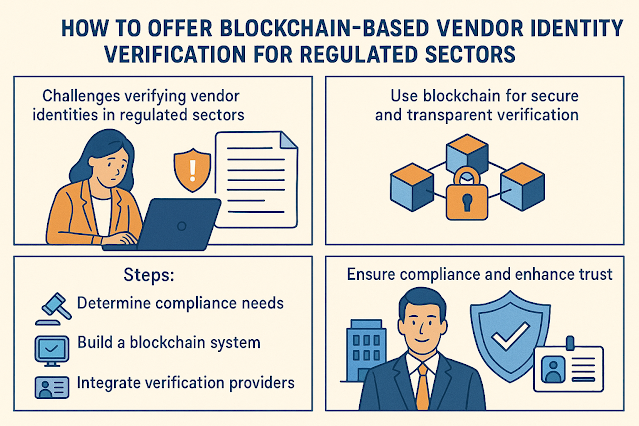How to Offer Blockchain-Based Vendor Identity Verification for Regulated Sectors
How to Offer Blockchain-Based Vendor Identity Verification for Regulated Sectors
In regulated industries like finance, healthcare, and defense, the stakes are high when it comes to knowing who your vendors are.
Traditional identity verification methods are slow, fragmented, and vulnerable to fraud or human error.
Blockchain technology offers a decentralized, tamper-proof way to verify vendor identities with greater security and transparency.
In this post, we’ll walk through how to launch a blockchain-based vendor identity verification system tailored for compliance-heavy environments.
📌 Table of Contents
- Why Regulated Sectors Need Strong Vendor Identity Verification
- How Blockchain Enhances Identity Verification
- Step-by-Step Implementation Guide
- Best Tools and Frameworks
- Real-World Case Study
- Further Resources
💼 Why Regulated Sectors Need Strong Vendor Identity Verification
In sectors like finance or government defense contracting, knowing who your vendors are isn’t optional—it’s legally required.
Failure to comply with Know Your Vendor (KYV) or anti-money laundering (AML) regulations can result in hefty fines and reputational damage.
Manual checks leave room for document forgery, impersonation, or outdated data.
Blockchain technology steps in as a more secure alternative by ensuring identities are verified once and immutably stored across a distributed ledger.
🔐 How Blockchain Enhances Identity Verification
Blockchain decentralizes data storage, making it impossible to alter past records without consensus from the network.
When vendors go through identity checks—whether through biometric verification, business registration checks, or government-issued documents—the outcome can be hashed and logged immutably.
This creates a single source of truth accessible across a permissioned network, ideal for auditors and regulators.
Plus, smart contracts can enforce identity expiration rules, revocation of access, and automated re-verification.
🚀 Step-by-Step Implementation Guide
1. Define Your Compliance Requirements:
Start by analyzing the specific regulations that apply to your sector—such as HIPAA in healthcare or FINRA rules in finance.
2. Choose a Blockchain Type:
Private or consortium blockchains like Hyperledger Fabric or Quorum are preferred for their permissioned access control.
3. Integrate Identity Verification Providers:
Use services like Jumio, Trulioo, or Onfido to conduct KYC/KYB processes and hash the results onto the chain.
4. Develop a Vendor Portal:
Vendors should have an intuitive interface to upload documents and view their verification status.
5. Create Smart Contracts:
Use smart contracts to automate the verification logic, expiry alerts, or access controls based on vendor trust scores.
6. Conduct Security Audits and Compliance Tests:
Use third-party blockchain auditing services to certify your system is compliant and tamper-proof.
🛠️ Best Tools and Frameworks
Several blockchain platforms offer robust frameworks for identity management:
- 🧱 Hyperledger Indy: Designed for decentralized identity with zero-knowledge proofs.
- 🔗 uPort: A self-sovereign identity platform for Ethereum networks.
- 🛡️ Civic: Offers identity verification services with a blockchain backend.
For document verification and biometric data onboarding, pair with trusted services like:
📊 Real-World Case Study: IBM Trust Your Supplier
IBM’s “Trust Your Supplier” network is a real-world example of blockchain-based vendor identity verification.
The platform allows businesses to manage supplier onboarding and verification using IBM Blockchain (built on Hyperledger Fabric).
It reduces onboarding time by up to 70%, removes duplicated identity efforts, and boosts transparency across the supply chain.
📚 Further Resources
To dive deeper into this topic and find practical frameworks and compliance checklists, refer to the resources below:
Conclusion:
Blockchain-based vendor identity verification isn’t just a technological leap—it’s a trust multiplier.
As regulatory requirements become stricter, companies that invest early in these systems will gain both legal cover and market advantage.
From eliminating manual paperwork to enabling secure real-time auditing, blockchain reshapes how regulated sectors handle vendor integrity.
Keywords: blockchain identity verification, regulated sectors, KYV compliance, vendor onboarding, Hyperledger Fabric
Step-by-step guide to getting a mortgage in Dallas, Texas.
Read the full postTips on securing a loan in Honolulu, Hawaii with ease.
Read the full postLearn how to finance a home purchase in Cleveland, Ohio.
Read the full postA complete overview of mortgage options in Charlotte, North Carolina.
Read the full postUnderstand how to qualify for loans in San Diego, California.
Read the full post